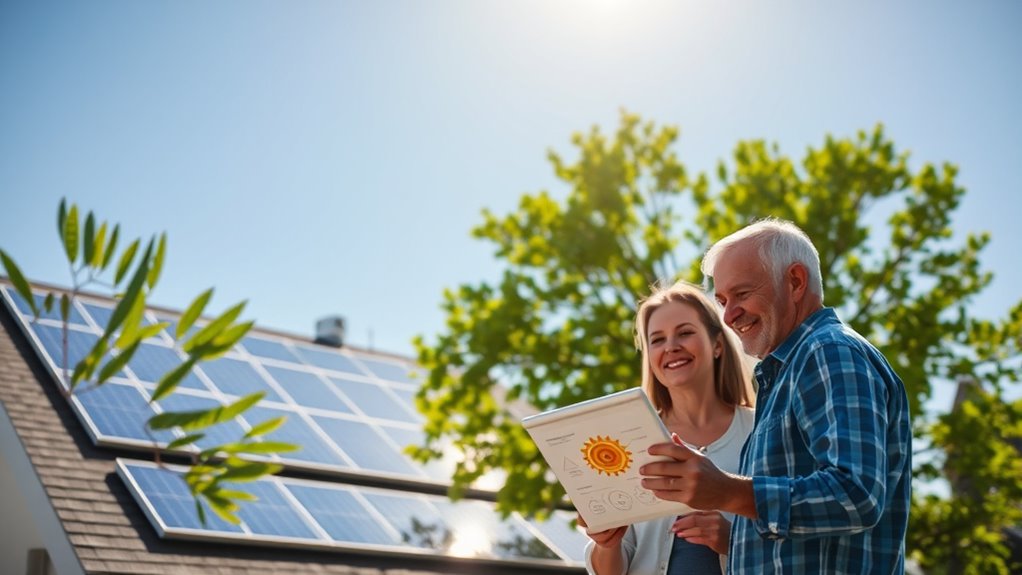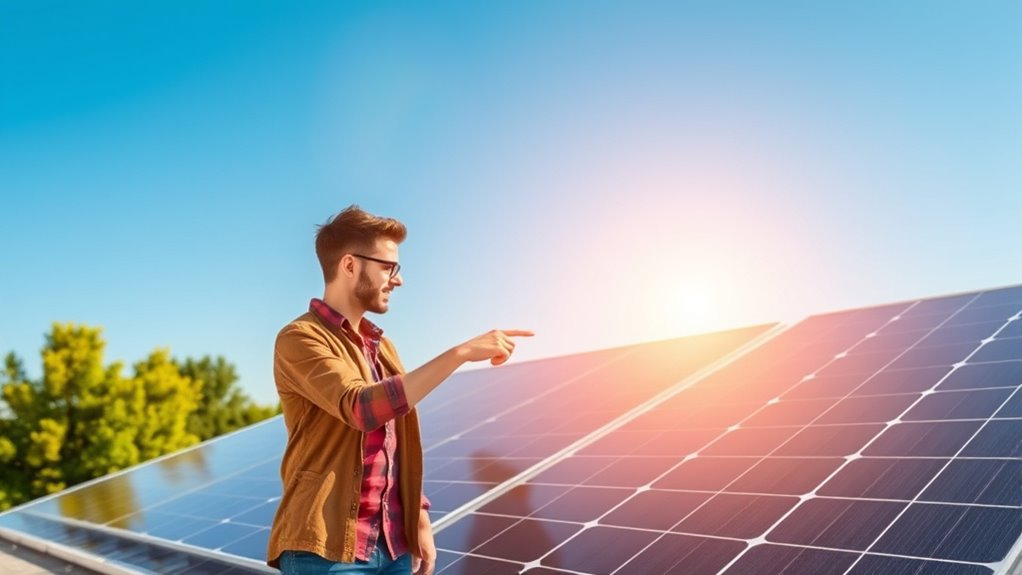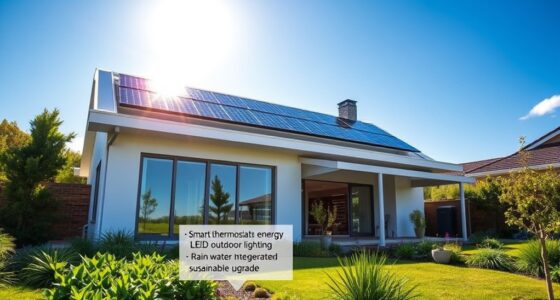Considering solar energy? To decide if it’s right for you, evaluate your energy needs, roof space, and how much sunlight your property gets, especially in shaded or limited areas. Understanding panel efficiency and available incentives can lower upfront costs and boost savings long-term. High-efficiency panels and government rebates make solar a smart choice for many. To explore whether solar fits your situation and how to maximize benefits, keep exploring this helpful guide.
Key Takeaways
- Assess your energy needs and property conditions to determine if solar installation is practical and beneficial.
- Consider solar panel efficiency and space constraints to optimize system performance and output.
- Explore available government incentives, rebates, and tax credits to reduce upfront costs.
- Balance the initial investment with potential long-term savings and environmental benefits.
- Consult with professionals to evaluate your site’s suitability and select the best solar solution.

Solar energy is an increasingly popular and accessible way to power your home or business while reducing your environmental impact. When considering solar, one of the first things to understand is solar panel efficiency. This term describes how well a panel converts sunlight into usable electricity. Higher efficiency panels produce more power in a smaller space, which is especially important if you have limited roof area. Modern panels typically range from around 15% to over 22% efficiency, with higher-efficiency models often costing more upfront but offering better long-term savings. It’s worth researching different types of panels to find one that balances cost and performance for your specific needs.
Another key factor to consider is government incentives. Many governments, both local and national, offer programs designed to make installing solar more affordable. These incentives can include tax credits, rebates, or low-interest financing options. For example, in some regions, you might qualify for a federal tax credit that covers a significant percentage of your installation costs. State and local programs might also provide additional rebates or incentives, boosting your overall savings. Taking advantage of these government incentives can substantially lower your initial investment, making solar energy a more attractive option.
Taking advantage of government incentives can significantly reduce your solar installation costs.
Before you jump into a solar project, it’s essential to evaluate your energy consumption and your property’s suitability for solar panels. Consider your historical energy bills to estimate how much sunlight you need to generate sufficient power. Your roof’s orientation, shading, and structural integrity will influence your system’s efficiency and overall output. A professional assessment can help you determine the ideal size of your solar array and ensure your investment is worthwhile.
Understanding solar panel efficiency and available government incentives can help you make an informed decision about whether solar energy is right for you. Higher efficiency panels mean more power generation in a smaller space, which might be vital if your roof is limited or shaded. Meanwhile, government incentives can considerably reduce your upfront costs and improve your return on investment. Additionally, considering the technology used in panels can affect performance and durability over time. By carefully evaluating your energy needs and taking advantage of available programs, you can make the switch to solar more accessible and cost-effective. Ultimately, embracing solar energy allows you to lower your electricity bills, reduce your carbon footprint, and contribute to a sustainable future.
Frequently Asked Questions
How Much Does Installing Solar Panels Typically Cost?
The cost estimation for installing solar panels typically ranges between $15,000 and $25,000 before incentives. This varies based on system size, location, and installation complexity. You can explore financing options like loans, leases, or power purchase agreements to make it more affordable. Keep in mind that government incentives and tax credits might substantially reduce your upfront costs, making solar energy a more accessible investment for you.
What Are the Maintenance Requirements for Solar Energy Systems?
Imagine your solar panels basking in sunlight, quietly producing power. To keep them at their best, you’ll want to follow simple cleaning routines—removing dust or leaves that settle on the surface. Regular system monitoring helps catch issues early, ensuring peak performance. With minimal effort, these maintenance tasks keep your solar energy system running smoothly, providing clean power and peace of mind for years to come.
Can Solar Panels Work During Cloudy or Rainy Days?
On cloudy or rainy days, solar panel efficiency drops because weather impact reduces the amount of sunlight reaching your panels. While they can still generate some electricity, their output is markedly lower compared to sunny days. Modern panels are designed to work in diffuse light, but expect a decrease in energy production. You can mitigate this by choosing high-efficiency panels or adding a battery system to store excess energy for cloudy days.
Are There Any Government Incentives for Solar Energy Adoption?
You can benefit from government incentives like grants and tax credits when adopting solar energy. These programs help reduce your upfront costs and make solar panels more affordable. Many local, state, and federal initiatives are available, so you should check what’s offered in your area. Taking advantage of government grants and tax credits can markedly lower your investment and accelerate your shift to clean, renewable energy.
How Long Do Solar Panels Usually Last Before Needing Replacement?
Ever wondered how long your solar panels will serve you? Typically, they last around 25 to 30 years, but panel degradation gradually reduces efficiency over time. Don’t worry—most panels come with warranty coverage that protects against early issues. Proper maintenance can extend their lifespan, ensuring you get the most out of your investment. So, are you ready to benefit from decades of clean, renewable energy?
Conclusion
Now that you’ve explored the basics of solar energy, you’re standing at the crossroads of a brighter future. Think of solar power as a garden waiting to bloom—your efforts can turn sunlight into savings and sustainability. If you’re ready to harness the sun’s power, it’s time to take the leap. The sky’s the limit when you choose solar—your journey to greener living starts today, shining brighter with every step you take.









